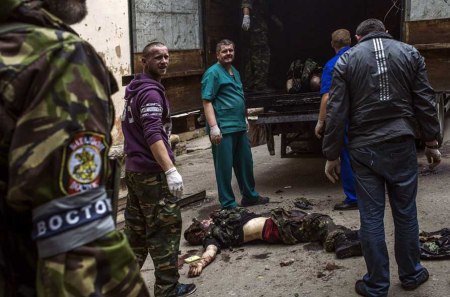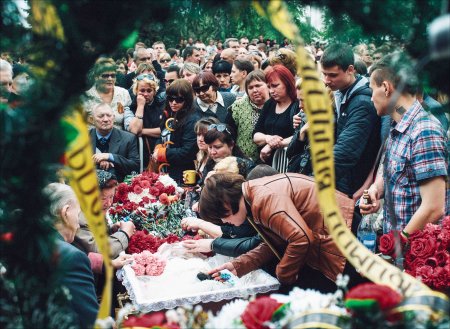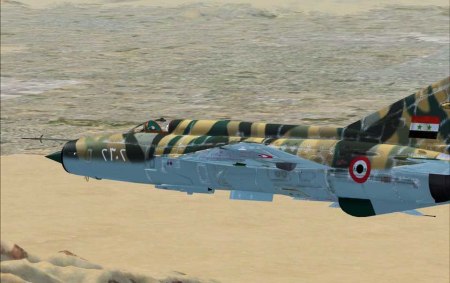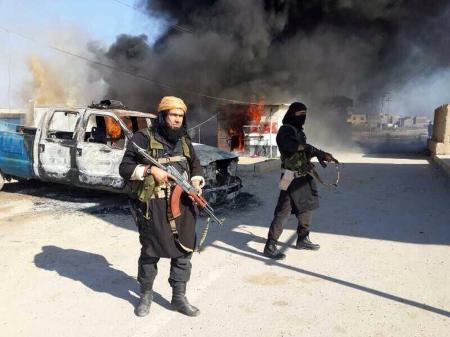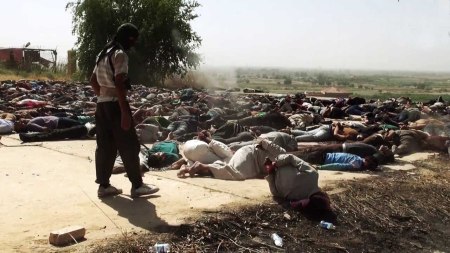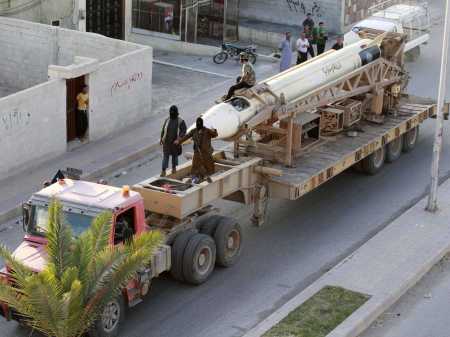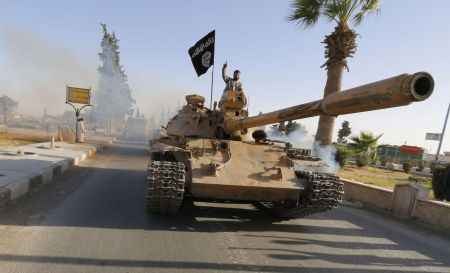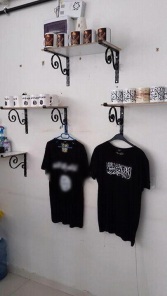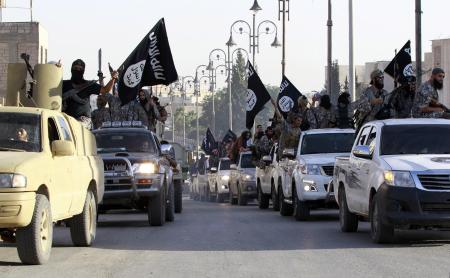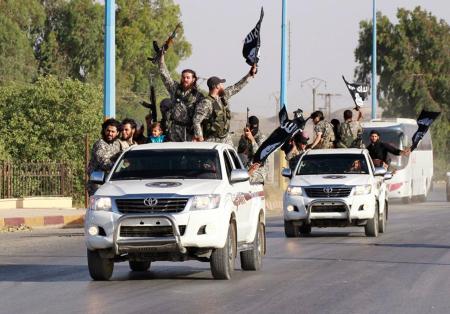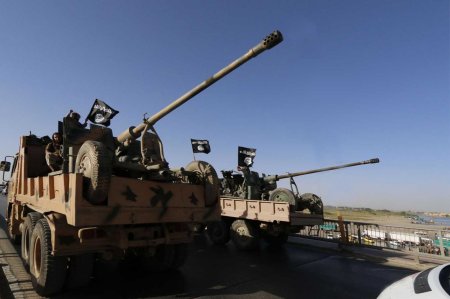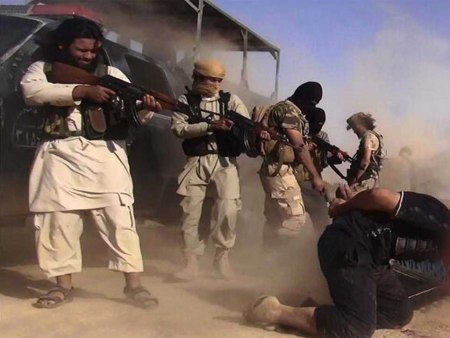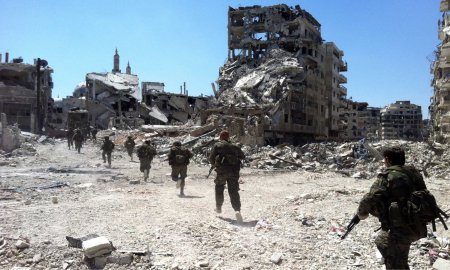The interview was conducted on August 21, 2014 and published by slavyangrad.org
If we were to speak of the operations which my unit carried out, I must caution: the word “operations” is an exaggeration. Currently the war is mainly being fought in the media field: It is an information war. The actual military activity is merely an extension. It is of utmost importance for Ukraine to destroy the idea for which we stand, and the weapons merely aid the physical destruction of the people who carry these ideals in their hearts.
We used to be, in structure and organization (by accumulating miners, taxi-drivers, farmers in our ranks), a battalion. Now we’ve grown into a brigade.
Actually, what we have been engaging in is difficult to call an “operation” per se. This is despite the fact that we work with maps, organize reconnaissance, and abide by staff timetables, as required in a military unit. We locate the whereabouts of the enemy units, of materiel, and of the movements of the enemy.
We have altered our original tactics. The main flaw of the initial design was the fact that we viewed this war as purely a physical struggle, whereas the Ukraine forces are not only incapable of fighting clean but also do not desire to. What does it matter to them? They have rocket launchers; they have Grads, Uragans, Smerches — why not use them? And they do. Also they call their operation the ATO (Anti–Terrorist Operation). But where, in what country, does an entire army fight against terrorism?
In my understanding, a fight with terrorism is a localized measure, a special operation. Once you destroy the terrorists, you are done. But this war has already lasted six months, and is gradually becoming harsher and bloodier with every passing day.
Here are the outlines of a few situations in which my unit has participated. I will start with the failures — the defense of Lisichansk. To suppress our forces, Ukraine threw eleven thousand men at us. Our lack of success was characterized by the fact that we were still true to the original tactics — the tactics of a clean fight: Creating a clear front, setting up checkpoints. That was a mistake. This war, constructed by Ukies, is built on deceit from the news to the battlefield. And because we were expecting a clean fight, we suffered casualties. I feel the loss of my men, most severely. For me, a loss of even a few individuals is a painful blow.
Yes, we have won fights; we pushed the enemy and they retreated, but they always returned in greater numbers and with more weaponry. Here is a shining example of this pattern. They set up a checkpoint at Staraya Krasnyanka, between Kremennoye and Rybezhnoye. We worked it over ten times. One day we destroy it; the next morning it is already manned with new people. Today deserted, tomorrow morning new people. The Ukies load up Kamaz trucks with corpses and straight away, brought in new personnel — new men destined to become corpses the following day.
One gets the impression that their soldiers are not informed about what is happening. The newcomers do not know what happened to their predecessors. They arrive uplifted, ignorant of their future. What they think about at the time of arrival is a mystery. They are surrounded by the clear signs of a recent struggle: The transport, the checkpoint, everything stained a dirty crimson. Those fresh forces are blameless people; obligated into service and threatened with prison. If you don’t join the military, you’ll spend 7 years locked-up. They are incapable of putting aside life for 7 years. They go to war, hoping to survive.
The tactics of the Ukrainian army can be summed up this way: they have placed the full weight of war upon the artillery and the rocket launchers. They commence an attack with a purge of territory, which they do using Grads and self-propelled artillery systems.
They call it targeted attacks but the outcomes of such attacks are huge areas, whole squares swept “clean.” Afterwards, the tanks arrive with means to destroy in case anyone is left alive somewhere. Finally, their armored personnel carriers follow, manned with soldiers to finish up. It seems like their tactics are unbeatable. That is the reason why we’ve changed our own tactics.
Even though we have grown in numbers, I refuse to send men into the open. We prefer to work in saboteur-reconnaissance groups (SRG): They go, they look, they work, and they return. That’s all. We work on their communications; we work on their distributions and their ammunition warehouses. If they don’t have ammo, they don’t have the ability to fire.
Only yesterday I was informed about the destruction of a column of 10 Ural trucks that were delivering missiles for the Grads, which were headed toward Donetsk. What can be more effective? Even if they have the launchers, without the shells those are simply piles of scrap metal, ballast. We hit them with RPGs and “Shmels” grenade launchers.
My original profession was in the creative field. I was a conductor of a wind (brass) orchestra, but even before the war I didn’t work in that field. I worked as a builder, as a construction worker. Now, I’m in charge of a mortar battery — also a “wind instrument”. That’s life.
From early childhood I dreamed of being a military man. Back then, we had a Defense Minister called Kuzmuk, he was part of Kuchma’s government. The levels of corruption in the army had reached head-spinning highs and I failed to get into the academy.
The main thing now is to allow for the maximum survival of our troops. Because it is these men, spread among the units, who carry the will of the people. Because it is these men who can become the basis, the pillars, of everything we fight for. That is also the reason why these men are targets, they can create a government, an administration of the people, a collaborative force. They are absolutely essential to our future and because of that I am desperate to protect them.
I think that Novorussia will be a republic — an autonomous part of Russia. I stand for the creation of the exemplary governance that is required, within the sovereign Republic of Novorussia. Taking that as a foundation for future regulation and direction, correction and distribution among the other regions; for currently it is not only Ukraine and Russia that are suffering from a political crisis, but the whole world.
It is one thing to wish for an ideal government, while sitting in a café and modeling such from reading books, but it is another thing when — in order to win it in battle and to conquer destroyed territory — the ideal government model must take a step back, delayed into the future, to allow room for the necessary, super-centralized, military present.
The commanders act in unison. There is a coordinating centre, a headquarters. At this moment in time, all the puzzle pieces have come together. There is a single control centre, a Council of War, and reliable, secure communications among the commanders. The same picture is held true for both regions, Lugansk and Donetsk, and it has united the military. Occasionally, the unit commanders meet up, but combining all the units in one place might have dire consequences. Currently, our people are dotted throughout different garrisons. The more complex and confusing our actions are, the more spread out we are, the greater are the chances of our survival, which is presently the main objective.
There are now ranks in a brigade. We have Brigade Commanders, Deputy Brigade Commanders, Heads of Units and Battalion Commanders. We have Squad Leaders, a Logistics Deputy, Head of Medical, Head of Communications. The whole staff structure is filled with real people. The majority of them were yesterday’s laborers who truly want to fight. If all we are left with is one single unit, we will still have a lot to show.
The dominating figure is Igor Strelkov. He must be not only dominating, but unique. I came to him when it all started and stood under his command. His ideal is identical to mine and he honestly fights for it.
How can I formulate that idea? Conscience. That is what a human must have, a conscience. Honor and dignity, virtue, righteousness. All else is just chatter. The main thing is to have a conscience, preferably a spotless one. It is that conscience which is constantly tested and tempted by war — it is a constant trial of conscience, of virtue. War is a litmus paper. Every person is clearly seen for what they are, be it a private or a general.
Certain shocks to our society are necessary, healthy even. But war is bad.
The events of Maidan have prompted talks, the western Ukrainians are passionate people. The south-eastern people are sluggish and sleepy Russians — their fire extinguished. But it is in the south-east nevertheless, where emotions are suddenly flaming — the fire is scorching and blinding.
Maidan chanted against oligopoly and against the corrupt officials, a great notion. While they danced for the truth, we went to work, earning a living. The result of their “dance” was pain. They went from the frying pan into the fire. The government didn’t just change, it went from bad to worse: the same oligarchs, the same corrupt ministers and officials, the same stale faces, selling power, influence, and people, which they were supposedly obliged to guide and protect. What changed? Suddenly the same people were marching to protect the government! That is absurd, strikingly so. I cannot hide the amazement at my own nation. They should be fighting against the people who have pushed them into this war, but instead, they are dying for them.
What was the point of Maidan? Why orchestrate this bloody spectacle, which only worsened the situation, as an alternative to some sort of constructive action? This behavior can only be explained as the result of totalitarian propaganda.
The rank of Political Commander (Politruk) was made obsolete sometime ago. In the Ukrainian army “politruks” became educators. In the most basic of terms: no political questions were raised, no political direction was given; only the psychological state of the enlisted was kept at a certain level. Even the army, it turns out, blocked the path of patriotism although it is the only authority on which patriotism could stand.
Regrettably, my brigade lacks political organization. It’s hard to create a conventional military unit from farmers and builders. But — even with a desperate lack of specialists — to create the exact system as it should be, has turned into my task. We have a brigade information centre, which collects and distributes information to and from the “great land,” so to say.
We get the information from the internet but the Ukies are constantly attempting to cut us off. Both mobile and satellite communications disappear for days at a time. We are constantly changing our location. Our area of responsibility is in the front line on the flanks of the Pervomajsk, Artemovsk, and Debaltsevo, the precise track that the Ukies follow down, and Veselaja — Tarasovka-Lutugino.
We have problems with our supplies. The market stalls may be empty, but we’ve located warehouses within the city, filled with meat, fish, and poultry which, for some strange reason, failed to make it into the shops. It turned out, the warehouses belong to the same owner. We confiscated the contents. All of it has been given away, to kindergartens, orphanages, and the needy. For us, food is what unites our people — our Russian populations. There are separate individuals who give but ask that they are not be mentioned. We are thankful for everything we get.
The struggle will most definitely continue. The main thing now is to keep our spirit — the spirit of commitment, the aspiration and the hope for truth and victory. If our people keep all three, we will be victorious. Yes, we have Lugansk and Donetsk, but the territory of Novorussia is not just these two cities. The territory of Novorussia is huge; I believe, it will aid us greatly.
There is war weariness among civilians. After the first couple of weeks of war, they were already screaming “we are tired of it!” I ask the question “How would you have reacted if this were the Second World War? Your grandfathers fought, spending years in the trenches. Were they not tired? You just heard shots fired, watched the news of someone’s death, and you are already tired.” Today, it is virtually the same war, fighting the same Fascism.
The men that are in combat, they are not tired. Sometimes, I even struggle to hold them back, hoping to avoid needless deaths and casualties. The men, who stand in the line of fire, are ready to fight to the last.
The miners have been slow to join the resistance. There is talk, that if the miners would rise, Kiev would disappear… But, for the time being, most of them still go down into the mines. Back when we stood near Lisichansk, the Ukies fired upon one of the mines — Krivoljanskaja. It was night and the night-shift was down there. Almost all of them died. But the next day, another shift nevertheless came back to work!
Another story… Another area south of Sverdlovsk. A bus full of miners, men and women, was shot at from a Ukrainian block-post. Just shot at! The Ukies didn’t know who was aboard, they just shot at those people who were going to work. I have a question for those people: “What do you think about, driving past the war and the shooting?” Do they think about work, about a slice of bacon? About what? There is a war on; they are killing you! Civilians, going to work like sheep into a slaughter house, not even resisting!
Is it the fear of losing a job? “How will I feed the family?” But, what do the families of the resistance eat? What do the children of the men that protect you, eat? Yes, it’s difficult now, very difficult, but they understand that it’s time to forget about an excellent borsht, a well-laid table. If there is something on the table — that’s enough. The main thing is to endure and to win, to prove that we are not a herd, not a biomass (as Timoshenko stated), but that we are people, individuals. We are people; we are ready to hold the government true to their promises.
In the brigade are heroes; there are the heroically fallen. Heroism is most evident among the generation which caught all those old movies, books, and tales of grandfathers and grandmothers. It’s in their blood — if not me, then who? I must, and that’s all.
Right now, the Commander of the first platoon of Vladimir lies in hospital. He’s a heroic individual, awarded with a medal “For Military Merit.” Thanks to his dedication and utter disregard of himself, his troop survived. Another unit also survived following Vladimir’s orders to retreat from approaching tanks while he remained. Alone. We had a hand-made personnel carrier that we nicknamed “Combat”. We sewed it up with armaments, armored it with a gun. Vladimir remained inside, fighting — alone! — holding back the enemy; covering his troops until they retreated to safety.
Eventually a shell hit “Combat” and ripped his arm from his body. He passed out. At the time of impact, the wound was burned. Thus, the wound was cauterized and there was hardly any bleeding. After some time, Vladimir regained consciousness and noticed that his arm was torn off, hanging by a thread of skin. He took the arm and put it into his coat, buttoned up and started walking. 24 hours he walked. Alone! He managed to escape from the surrounding forces — avoided all enemy posts. From all the weapons, he had a Makarov with a single bullet, just in case. The right arm was tucked into the coat; the left held a gun. The severed limb was not saved.
Another episode of courage: One of the first battles in Lisichansk back when we had block-posts. We had a guy, Dima, who was killed right at the beginning of the military action. Thanks to his acuteness, proficiency and self-sacrifice, many survived. He took the whole Ukie fire — all the guns turned on him. All of them. Once the unit had arrived from the march, it was necessary to start helping to hold the Jandovskij block-post. While everyone was still getting into position, at that moment Dima hit the target causing the enemy to fire upon himself and he was the first to be killed. Because of his actions, the others survived. Not only did they continue the fight but they managed to push the Ukies back, destroying the block-post they had occupied. All due to the sacrifice of one man.
This is who we must be — heroes, knights. Because we are Russians, we are Slavs, we cannot be anything else. We do not have the right to be anything else.
From the weapons we hold — MANPADS and paired ZAUs (automatic anti-aircraft guns) — we work the planes. But the Ukies, once they figured out that we can get them, changed tactics; they don’t descend to the height where we can hit them, but drop bombs from far above, of a massive size. They drop two or three, and disappear.
The Ukies claim to be fighting terrorism, while bombarding peaceful, innocent civilians, destroying whole city blocks and infrastructure. All of it! How is that? If you are at war with us, fight us. But instead, they bombard cities and blame it on us… We have proof of the bombings: The weapons used and the directions from which the fire came. The flight trajectory can be calculated from the remaining crater. But, there is no arguing their impudent allegations; the unfounded, falsified claims.
Before, it was commonly believed that such a war with field commanders, a civil war, is a disaster. It is difficult to organize, to create a common structure. Untrained militia forces are impossible to control. Yes, sometimes you have to shout, punish, and send men into lock-up, once a certain line is crossed. Every military establishment has its breaches but we are bound together by the same idea, united by a common belief. If we want to accomplish anything, we must be disciplined and structured. That stayed with us from the beginning — from that very first unit we formed. Even before the military attacks commenced, I began to organize the resistance of the people because I could see that it was necessary to be ready. Even then, we agreed that we must reach our final aim — we must be victorious. The rest, as to who was right and who was to blame, we’ll let time decide. A clear structure has formed, and all are committed to it.
The fight began when such categories as Novorussia, did not exist. This concept arose in the course of battles and it gradually grows more and more, and gains more meanings. Now Novorussia is not just a territory, it is also an idea. Liberty and Conscience is and will be the new Russia.


